

Fluidyne. Stirling. The idea is credited to a Scottish inventor called Robert Stirling in 1816.
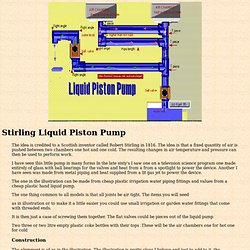
The idea is that a fixed quantity of air is pushed between two chambers one hot and one cold. The resulting changes in air temperature and pressure can then be used to perform work. I have seen this little pump in many forms In the late sixty's I saw one on a television science program one made entirely of glass with ball bearings for the valves and heat from a from a spotlight to power the device. Another I have seen was made from metal piping and heat supplied from a lit gas jet to power the device. Other Engines. Other's Engines Revised 15 June 2003 This page will feature engines that others have built, but that we have found interesting.
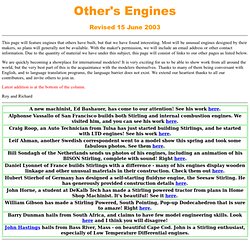
Most will be unusual engines designed by their makers, so plans will generally not be available. With the maker's permission, we will include an email address or other contact information. Due to the quantity of material we have under this subject, this page will consist of links to our other pages as listed below. We are quickly becoming a showplace for international modelers! Instituto CEDIAC. Home - Böhm Stirling-Technik. Heteluchtmachines. Any knowledge on the Stirling engine. Stirling Technology, Inc. It has come to our attention that in Asia, specifically South Korea and China, there are companies with similar names who are representing themselves as being part of Stirling Technology, Inc. and UltimateAir.
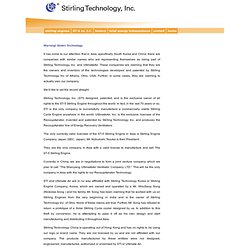
These companies are claiming that they are the owners and inventors of the technologies developed and patented by Stirling Technology Inc of Athens, Ohio, USA. Further, in some cases, they are claiming to actually own our company. We'd like to set the record straight. Stirling Technology, Inc. (STI) designed, patented, and is the exclusive owner of all rights to the ST-5 Stirling Engine throughout the world. The only currently valid licensee of the ST-5 Stirling Engine in Asia is Stirling Engine Company, Japan (SEC, Japan), Mr. They are the only company in Asia with a valid license to manufacture and sell The ST-5 Stirling Engine. Currently in China, we are in negotiations to form a joint venture company, which we plan to call “The Shenyang UltimateAir Ventilator Company, LTD.”
Liney Machine : Heat pump and refrigeration cycle. Thermodynamic heat pump cycles or refrigeration cycles are the conceptual and mathematical models for heat pumps and refrigerators.

A heat pump is a machine or device that moves heat from one location (the 'source') at a lower temperature to another location (the 'sink' or 'heat sink') at a higher temperature using mechanical work or a high-temperature heat source.[1] Thus a heat pump may be thought of as a "heater" if the objective is to warm the heat sink (as when warming the inside of a home on a cold day), or a "refrigerator" if the objective is to cool the heat source (as in the normal operation of a freezer). In either case, the operating principles are identical.[2] Heat is moved from a cold place to a warm place. Thermodynamic cycles[edit] Heat pump and refrigeration cycles can be classified as vapor compression, vapor absorption, gas cycle, or Stirling cycle types.
Vapor-compression cycle[edit] Figure 1: Vapor-compression refrigeration. Stirling cycle. This article is about the "adiabatic" Stirling cycle.
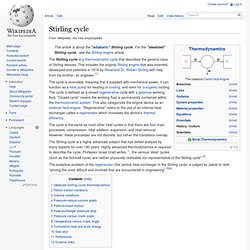
For the "idealized" Stirling cycle , see the Stirling engine article. The Stirling cycle is a thermodynamic cycle that describes the general class of Stirling devices. This includes the original Stirling engine that was invented, developed and patented in 1816 by Reverend Dr. Robert Stirling with help from his brother, an engineer.[1] The cycle is reversible, meaning that if supplied with mechanical power, it can function as a heat pump for heating or cooling, and even for cryogenic cooling. Stirling engine. Alpha type Stirling engine.
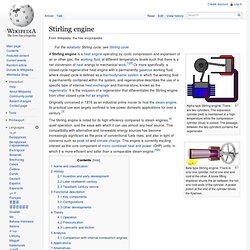
There are two cylinders. The expansion cylinder (red) is maintained at a high temperature while the compression cylinder (blue) is cooled. The passage between the two cylinders contains the regenerator. Beta type Stirling engine. There is only one cylinder, hot at one end and cold at the other. Originally conceived in 1816 as an industrial prime mover to rival the steam engine, its practical use was largely confined to low-power domestic applications for over a century.[3] The Stirling engine is noted for its high efficiency compared to steam engines,[4] quiet operation, and the ease with which it can use almost any heat source. Name and classification[edit] Robert Stirling was a Scottish minister who invented the first practical example of a closed cycle air engine in 1816, and it was suggested by Fleeming Jenkin as early as 1884 that all such engines should therefore generically be called Stirling engines. History[edit] Invention and early development[edit]
Other Stirling engines - Мозилин фајерфокс (Mozilla Firefox) There are other types of Stirling engines than those studied in the specific pages of this site.
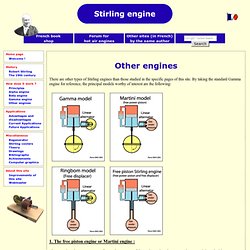
By taking the standard Gamma engine for reference, the principal models worthy of interest are the following: 1. The free piston engine or Martini engine : The operating piston moves according to the pressure of the engine. When the pressure increases, it is pushed in one direction. 2. In contrast to the previous one, the piston is mechanically driven. 3. This engine combines the advantages of the previous models.The great advantage is that one can obtain an absolute sealing because there does not exist any mechanical connection with outside. 4. Motore stirling HB-9.